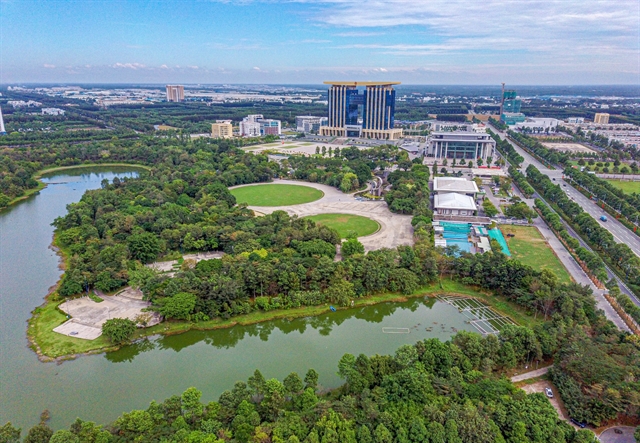
HÀ NỘI — Disbursement of foreign direct investment (FDI) experienced a positive yearly increase of 7.8 per cent to US$7.71 billion in the first five months of this year, as the national economy appears to be back to normal, according to the Foreign Investment Agency (FIA) under the Ministry of Planning and Investment.
The Government and relevant agencies’ continual and effective assistance, along with efforts by enterprises to weather the pandemic and adapt to the new context, have helped firms gradually recover, maintain, and expand operations. That’s why the disbursed capital has been rising over the past months, the agency explained.
Though the registered capital in the five-month period, $11.71 billion, was equivalent to just 83.7 per cent of the figure in the same period last year, only investment in new projects declined by 53.4 per cent to $4.12 billion while the capital poured into existing projects surged 45.1 per cent to hit $5.61 billion.
Capital contributions and share purchases by foreign investors also witnessed a significant year-on-year rise of 51.6 per cent to $1.98 billion.
The FIA said in its latest report that despite the COVID-19 pandemic’s adverse impacts, foreign investors still put their trust in the economy and investment climate of Việt Nam in the new normal context, and decided to expand their projects in the country.
Among typical capital-added projects include the Thái Nguyên Province-based Samsung Electro-mechanics Vietnam project, which increased its capital by $920 million, and three plants for manufacturing electronics, network equipment and multimedia audio products in three localities of Bắc Ninh, Nghệ An and Hải Phòng which hike their investment by nearly $306 million, $260 million and $127 million respectively.
From January to May, the processing and manufacturing industry lured the lion's share of FDI with over $6.8 billion, accounting for 58.2 per cent of the total registered investment capital. The real estate sector came next with nearly $3 billion or 25.6 per cent, followed by the information and communication industry and science and technology sector with $398 million and $374.8 million respectively.
Singapore retained its position as Việt Nam's leading foreign investor with nearly $3 billion, making up nearly 25.3 per cent of the total FDI registered in the country. However, investment pumped by Singaporean businesses in the Southeast Asian country saw a strong decline of 44 per cent year-on-year.
South Korea's five-month investment in Việt Nam ranked second, surging 12.6 per cent year-on-year to over $2.06 billion or equivalent to 17.6 per cent of the total FDI and Denmark rank third with nearly $1.32 billion or 11.3 per cent thanks to large-scaled LEGO project.
Mainland China, Japan, and Hong Kong were the runners-up.
The FIA added localities luring the most FDI were the southern province of Bình Dương with $2.52 billion or making up 21.5 per cent of the nation's total FDI, the northern province of Bắc Ninh ($1.65 billion or 14 per cent) and HCM City ($1.3 billion or 11.3 per cent).
VN remains attractive to int'l investors: HSBC
An HSBC survey showed that up to 21 per cent of Indian firms operating or intending to operate in Southeast Asia plan to expand their business in Việt Nam in the next two years, and the ratio is 26 per cent among Chinese enterprises.
According to the survey covering more than 1,500 companies from six of the world’s largest economies – all of which have operations in Southeast Asia, three out of 10 surveyed companies pointed to a skilled workforce as an advantage of Việt Nam, while 27 per cent cited competitive wage prices and proven economic resilience in response to the pandemic.
Currently, 39 per cent of Indian companies stated they were attracted by the country’s infrastructure, while 39 per cent of US firms said that they are keen on opportunities to develop and test new products/solutions in the market.
Particularly, 49 per cent of surveyed firms, mostly from China, India and the US, said that they hope to make use of the EU-Việt Nam Free Trade Agreement (EVFTA) to strengthen and support their trade activities in the region.
At the same time, 33 per cent said that they have to face challenges in supply sources due to the impacts of COVID-19 in Việt Nam.
Cultural issues were also a major concern for 31 per cent of enterprises.
Sustainable development in Việt Nam also draws the attention of international investors. Among the international companies participating in the survey, 45 per cent of those with Vietnamese operations stated that the most important sustainability actions they could take were improving energy efficiency; a further 42 per cent underlined the importance of supporting local communities.
Some 31 per cent of respondent companies operating in Việt Nam worried that new regulations and rules on carbon reduction could impact them. Meanwhile, 36 per cent flagged the difficulty of hiring employees who possessed the correct sustainability credentials and knowledge.
Tims Evans, HSBC General Director in Việt Nam said that Việt Nam is an example of successful COVID-19 control. The country is rising as a global production hub thanks to the incentives given by the Government, especially in the signing of free trade agreements.
Through the discussions of HSBC Vietnam with multinational corporate clients, HSBC found that the trend of shifting investment to Việt Nam is not temporary, but strategic and long-term, he said. — VNS
Xem thêm: lmth.pu-tnemesrubsid-idf-htnom-evif-sman-teiv/2046021/ymonoce/nv.swenmanteiv